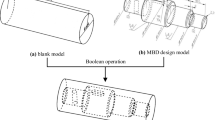Abstract
Turning is the one of the most commonly available and least expensive machining operations. Confronted with the increased number of part variants and the requirement for fast system responsiveness in dynamic environments, traditional methods for building a computer-aided process planning (CAPP) system for turning are infeasible due to the fixed feature library and hard-coded heuristic rules. In this paper, a customizable approach for automatic process planning of rotational parts is proposed to boost the productivity of enterprises by realizing multi-level machining feature recognition and knowledge-based machining activity/resource selection. First, from the decomposed cells of the turning area, basic turning features are successively recognized based on a novel cell machinability analysis. The high-level custom features are define based on the directed acyclic graph and recognized from the basic feature precedence graph using the subgraph matching algorithm. To facilitate the knowledge-based process planning, a knowledge base is then established utilizing ontology, in which the taxonomies, properties, and causal relationships among the core concepts, namely, machining feature, machining operation, cutting tool, and machine tool, are formally defined. Finally, a five-step procedure is proposed to automatically infer manufacturing activity/resource for multi-level features through rule-based reasoning. The effectiveness and extensibility of the proposed approach are validated through two case studies on complex rotational parts.



























Similar content being viewed by others
References
Deja M, Siemiatkowski MS (2018) Machining process sequencing and machine assignment in generative feature-based CAPP for mill-turn parts. J Manuf Syst 48:49–62
Yusof Y, Latif K (2014) Survey on computer-aided process planning. Int J Adv Manuf Technol 75(1-4):77–89
Ma H, Zhou X, Liu W, Li J, Niu Q, Kong C (2018) A feature-based approach towards integration and automation of CAD/CAPP/CAM for EDM electrodes. Int J Adv Manuf Technol 98(9-12):2943–2965
Li R-KW (1988) A part-feature recognition system for rotational parts. Int J Prod Res 26(9):1451–1475
Wu W, Huang Z, Liu Q, Liu L (2018) A combinatorial optimisation approach for recognising interacting machining features in mill turn parts. Int J Prod Res 56(11):3757–3780
Al-wswasi M, Ivanov A (2019) A novel and smart interactive feature recognition system for rotational parts using a STEP file. Int J Adv Manuf Technol 104(1-4):261–284
Liu L, Huang Z, Liu W, WenboWu (2018) Extracting the turning volume and features for a mill/turn part with multiple extreme faces. Int J Adv Manuf Technol 94 (1-4):257-280
Huang Z, Yip-Hoi D (2002) High-level feature recognition using feature relationship graphs. Comput Aided Des 34(8):561–582
Ming Z, Zeng C, Wang G, Hao J, Yan Y (2018) Ontology-based module selection in the design of reconfigurable machine tools. J Intell Manuf 31:301–317. https://doi.org/10.1007/s10845-018-1446-3
Verma AK, Rajotia S (2010) A review of machining feature recognition methodologies. Int J Comput Integr Manuf 23(4):353–368
Babic B, Nesic N, Miljkovic Z (2008) A review of automated feature recognition with rule-based pattern recognition. Comput Ind 59(4):321–337
Joshi S, Chang TC (1988) Graph-based heuristics for recognition of machined features from a 3D solid model. Comput Aided Des 20(2):58–66
Gao S, Shah JJ (1998) Automatic recognition of interacting machining features based on minimal condition subgraph. Comput Aided Des 30(9):727–739
Madurai SS, Lin L (1992) Rule-based automatic part feature extraction and recognition from CAD data. Comput Ind Eng 22(1):49–62
Wang Q, Yu X (2014) Ontology based automatic feature recognition framework. Comput Ind 65(7):1041–1052
Yip-Hoi D, Dutta D, Huang Z (2003) A customizable machining feature extraction methodology for turned components. J Manuf Syst 22(2):82–98
Li S, Shah JJ (2007) Recognition of user-defined turning features for mill/turn parts. J Comput Inf Sci Eng 7(3):225–235
Xia Q, Etienne A, J-y D, Siadat A (2018) Reconfigurable machining process planning for part variety in new manufacturing paradigms: Definitions, models and framework. Comput Ind Eng 115:206–219
Xu X, Wang L, Newman ST (2011) Computer-aided process planning – a critical review of recent developments and future trends. Int J Comput Integr Manuf 24(1):1–31
Leo Kumar SP (2018) Knowledge-based expert system in manufacturing planning: state-of-the-art review. Int J Prod Res 57(15-16):4766–4790
Oral A, Cakir MC (2004) Automated cutting tool selection and cutting tool sequence optimisation for rotational parts. Robot Comput Integr Manuf 20(2):127–141
Law HW, Tam HY, Chan AHS, Hui IK (2001) Object-oriented knowledge-based computer-aided process planning system for bare circuit boards manufacturing. Comput Ind 45(2):137–153
Helgoson M, Kalhori V (2012) A conceptual model for knowledge integration in process planning. Procedia CIRP 3:573–578
Feng SC, Song EY (2003) A manufacturing process information model for design and process planning integration. J Manuf Syst 22(1):1–15
Panetto H, Dassisti M, Tursi A (2012) ONTO-PDM: Product-driven ONTOlogy for Product Data Management interoperability within manufacturing process environment. Adv Eng Inform 26(2):334–348
Zhang Y, Luo X, Zhang H, Sutherland JW (2014) A knowledge representation for unit manufacturing processes. Int J Adv Manuf Technol 73(5-8):1011–1031
Kang M, Kim G, Lee T, Jung CH, Eum K, Park MW, Kim JK (2016) Selection and sequencing of machining processes for prismatic parts using process ontology model. Int J Precis Eng Manuf 17(3):387–394
Šormaz D, Sarkar A (2019) SIMPM – Upper-level ontology for manufacturing process plan network generation. Robot Comput Integr Manuf 55:183–198
Musen MA, Team P (2015) The protege project: a look back and a look forward. AI matters 1(4):4–12
Zhang Y, Luo X, Zhao Y, H-c Z (2015) An ontology-based knowledge framework for engineering material selection. Adv Eng Inform 29(4):985–1000
Sirin E, Parsia B, Grau BC, Kalyanpur A, Katz Y (2007) Pellet: a practical owl-dl reasoner. Web Semant Sci Serv Agents World Wide Web 5(2):51–53
Author information
Authors and Affiliations
Corresponding author
Additional information
Publisher’s note
Springer Nature remains neutral with regard to jurisdictional claims in published maps and institutional affiliations.
Rights and permissions
About this article
Cite this article
Ma, H., Zhou, X., Liu, W. et al. A customizable process planning approach for rotational parts based on multi-level machining features and ontology. Int J Adv Manuf Technol 108, 647–669 (2020). https://doi.org/10.1007/s00170-020-05437-0
Received:
Accepted:
Published:
Issue Date:
DOI: https://doi.org/10.1007/s00170-020-05437-0




